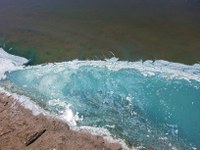Cyanobacteria Can be Toxic to Livestock, Wildlife, Humans
(Click the image below to view a high-resolution image that can be downloaded)
Cyanobacteria, also known as blue-green algae, can produce toxins that are harmful to livestock, wildlife and people.
Blue-green algae often occurs in stagnant ponds or dugouts with elevated nutrient levels, forming large colonies that appear as scum on or just below the water surface, according to Carl Dahlen, North Dakota State University Extension Service beef cattle specialist. Live cyanobacteria are green and turn blue after they die and dry on the water surface or shoreline.
Although cyanobacteria typically are a concern beginning in mid-July, an algae bloom in Walsh County recently tested positive for toxic cyanobacteria production, says Brad Brummond, agriculture and natural resources Extension agent in Walsh County.
Blue-green algae’s toxicity depends on the species drinking the water, and the concentration and the amount of water ingested.
Cyanobacteria produce neuro and liver toxins, NDSU Extension veterinarian and livestock stewardship specialist Gerald Stokka says. Signs of neurotoxin poisoning usually appear within 20 minutes of ingestion.
In animals, symptoms include weakness, staggering, difficulty in breathing, convulsions and, ultimately, death. Animals affected by liver toxins may exhibit weakness, pale-colored mucous membranes, mental derangement, bloody diarrhea and, ultimately, death. Typically, livestock are found dead before producers see symptoms.
Miranda Meehan, NDSU Extension livestock environmental stewardship specialist, recommends that if producers suspect cyanobacterial poisoning caused the death of livestock, they should check the edges of ponds for dead wildlife. Dead wildlife is an indication that cyanobacteria are in the water.
In addition, producers should collect a water sample from the suspected water source and submit it to the NDSU Veterinary Diagnostic Laboratory or a commercial laboratory. For information on how to submit samples, contact the lab at 701-231-8307 or visit its website at http://www.vdl.ndsu.edu/.
Here are some ways producers can prevent cyanobacterial poisoning of livestock:
- Reduce the nutrient levels entering the water source by implementing a nutrient management plan or establishing buffer strips with perennial plant species.
- Create a designated drinking area where the risk of cyanobacteria is minimal.
- Fence off the pond and pump water from the pond to a water tank.
- Use or provide other water sources following periods of hot, dry weather.
- Add copper sulfate to the water if the water source has a history of algae blooms. Apply 2 pounds of copper sulfate per acre-foot of water, which is equal to a rate of 8 pounds per 1 million gallons.
“With this early finding of blue-green algae, be sure to monitor livestock water sources throughout the summer and take immediate action to prevent cyanobacterial poisoning of livestock,” Dahlen says.
Check out the NDSU Extension Service’s “Cyanobacteria (Blue-green Algae) Poisoning” publication at http://tinyurl.com/NDSU-blue-green-algae for more information.
NDSU Agriculture Communication - June 16, 2016
| Source: | Carl Dahlen, 701-231-5588, carl.dahlen@ndsu.edu |
|---|---|
| Source: | Miranda Meehan, 701-231-7683, miranda.meehan@ndsu.edu |
| Source: | Gerald Stokka, 701-231-5082, gerald.stokka@ndsu.edu |
| Source: | Brad Brummond, 701-284-6248, bradley.brummond@ndsu.edu |
| Editor: | Ellen Crawford, 701-231-5391, ellen.crawford@ndsu.edu |


